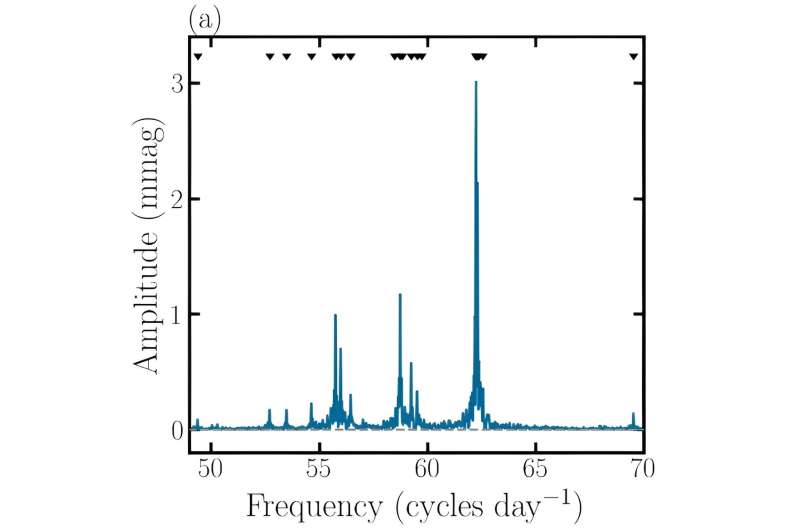April 10, 2024 report
This article has been reviewed according to Science X's editorial process and policies. Editors have highlighted the following attributes while ensuring the content's credibility:
fact-checked
preprint
trusted source
proofread
HD 21997 is a high-frequency Delta Scuti pulsator, observations find

Using NASA's Transiting Exoplanet Survey Satellite (TESS), astronomers have observed a young star designated HD 21997. Results of the new observations indicate that the studied object is a high-frequency Delta Scuti pulsator. The finding was described in a paper published March 28 on the pre-print server arXiv.
Detecting and studying variable stars could offer important hints into aspects of stellar structure and evolution. Investigation of variables could be also helpful for a better understanding of the distance scale of the universe. In general, there are two main-sequence A-F type pulsating variables: Delta Scuti and Gamma Doradus stars.
Delta Scuti stars are pulsating variables with spectral types between A0 and F5, named after the Delta Scuti variable in the constellation Scutum. They exhibit radial and non-radial pulsations spanning periods from 20 minutes to eight hours. Studying pulsation behavior of Delta Scuti variables could help us advance our knowledge about stellar interiors.
Now, a team of astronomers led by Aldo G. Sepulveda of the University of Hawaiʻi at Mānoa reports the detection of a new variable of the Delta Scuti type. With the help of TESS, they identified high-frequency pulsations in HD 21997—a star of spectral type A3, nearly two times as massive as the sun, which is known to host a hybrid debris disk with a carbon monoxide gas mass that is large for its age and dust properties.
"In the resulting amplitude spectrum, we identify 25 significant frequencies spanning ∼49–70 cycles day−1 by iteratively fitting sine waves to the time series down to a spectral significance threshold of 20 using Sigspec. These frequencies are consistent with pressure modes of Delta Scuti stars," the researchers wrote.
Located some 235 light years away, HD 21997 has a mass of about 1.8 solar masses and is estimated to be less than 50 million years old (most likely about 35 million years old). The star has a systemic velocity of approximately 1.29 km/s and its debris disk has an outer radius of 138 AU. Previous observations have found that HD 21997 is an associated member of the Columba young moving group.
The astronomers noted that the absolute G magnitude of HD 21997 is generally consistent with that of the population of known Delta Scuti stars. The rotation period of the star is still unknown and determining it will be essential to shed more light on its behavior.
The researchers underlined the importance of further investigation of HD 21997 in order to obtain the precise asteroseismic age of this variable. They explained that accurate age constraints for HD 21997 are necessary to interpret the dust and gas evolution both for the system and for hybrid disks as a population.
More information: Aldo G. Sepulveda et al, The Hybrid Debris Disk Host Star HD 21997 is a High-Frequency Delta Scuti Pulsator, arXiv (2024). DOI: 10.48550/arxiv.2403.19741
Journal information: arXiv
© 2024 Science X Network




















